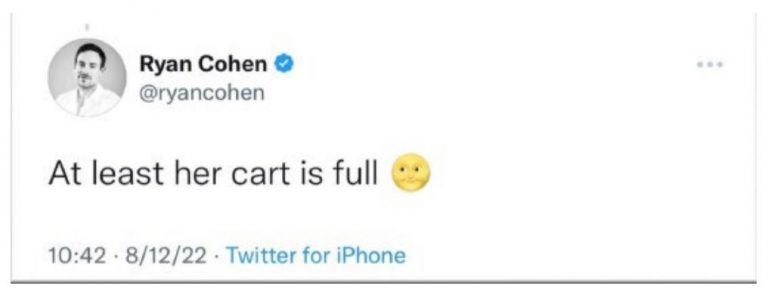A Single Emoji Could Constitute Securities Fraud–In re Bed Bath & Beyond
This case involves Ryan Cohen, who made a fortune running Chewy.com and then switched his interests to meme stocks. He bought a 9% interest in the failing retailer Bed Bath and Beyond, hyped the stock, and then liquidated his position, pocketing $68M in profits. BBB stockholders sued him for securities law violations.
In particular, in response to a negative story about BBB, Cohen tweeted:
If you don’t recognize the emoji, it’s the “full moon face” emoji. The court says that in some online circles, it’s used as symbolism that a stock price is headed “to the moon.” The court says this tweet could be a material misrepresentation:
The moon-emoji tweet was plausibly misleading because it was perceived “as a rallying cry to buy Bed Bath’s stock,” even though Cohen had soured on Bed Bath. Compl. ¶¶ 148–49; accord Friel v. Dapper Labs, Inc., No. 21-cv-5837, 2023 WL 2162747, at *17 (S.D.N.Y. Feb. 22, 2023) (finding same for rocket ship emojis).
Cohen objects that emojis can never be actionable because they have no defined meaning. In his view, “there is no way to establish . . . the truth . . . of a tiny lunar cartoon.” And similarly, emojis are at the very least “ambiguous.” But those claims get him nowhere.
To understand why, zoom out. Emojis are symbols. Like symbols, language can be ambiguous. If you say, “The Nats are going to win the World Series this year,” and your friend replies, “Right,” she may be agreeing with you, but it could also be a sarcastic reply. Context and tone help elucidate meaning. Just because language can be ambiguous does not mean it is not actionable or capable of being correctly understood.
So too with symbols. People use symbols as “a primitive but effective way of communicating ideas.” Sometimes, symbols are ambiguous. If you texted your friend to ask him to have dinner with you and he responded with the steak emoji, you might reasonably wonder if he wanted to go to a steak house or fire up the grill. But like language, a symbol’s meaning may be clarified by “the context in which [the] symbol is used.” So if you knew that friend had sworn off restaurants, then you could be more certain that he was up for a cookout.
So the Court declines Cohen’s blanket rule. Emojis may be actionable if they communicate an idea that would otherwise be actionable. A fraudster may not escape liability simply because he used an emoji. Just like with words, liability will turn on the emoji’s particular meaning in context.
There are far better examples of emoji’s semantic ambiguity than the judge’s “steak emoji” (technically the “cut of meat” emoji) example. Also, I wonder if the judge knows that the emoji can have sexual connotations. That slang usage puts another, and likely unwanted, spin on what the “friend” might be suggesting when he responded with the “steak” emoji. 🍆
Still, overall, the judge handles the semantic questions properly. Emojis are always capable of multiple meanings, as are most words and other communicative symbols, and they derive their specific meaning from their surrounding context. The capability of multiple meanings doesn’t render an emoji definitionless or fatally ambiguous. For more, see my Emojis and the Law paper.
The court then interprets what the full moon face emoji meant in this context:
Bratya has plausibly alleged that the moon tweet relayed that Cohen was telling his hundreds of thousands of followers that Bed Bath’s stock was going up and that they should buy or hold. In the meme stock “subculture,” moon emojis are associated with the phrase “to the moon,” which investors use to indicate “that a stock will rise.” So meme stock investors conceivably understood Cohen’s tweet to mean that Cohen was confident in Bed Bath and that he was encouraging them to act….
that meaning is actionable. For one, it is plausibly material. That is, there was a “substantial likelihood that a reasonable investor would consider it important.” Investors appear to have relied on it, driving Bed Bath’s stock price up in the following days…..
Nor is the tweet mere puffery. If Bratya had alleged only that the tweet expressed Cohen’s hope that the stock would rise, that would not be actionable. Likewise, if Bratya had alleged only that the tweet signaled Cohen’s excitement about Bed Bath, Bratya would have no claim. But Bratya has plausibly alleged that Cohen’s tweet was more, an expert insider’s direction to buy or hold
This opinion didn’t definitively resolve the meaning of the full moon face emoji. On the motion to dismiss, the judge simply accepted the plaintiffs’ allegations about its meaning as plausible. In further proceedings, Cohen may admit that the full moon face emoji has the meaning ascribed by the plaintiffs. At minimum, the plaintiffs will ask Cohen why he used the emoji and what he thought it meant; and they can cross-examine him on his explanation.
Depending on Cohen’s answers, the plaintiffs may need to introduce further written or oral evidence corroborating their asserted meaning. I don’t expect such evidence will be hard to obtain. It won’t require a linguistics or “emoji” expert, but the plaintiffs may want an expert in how the meme stock community uses the phrase “to the moon” and any associated emojis.
For now, take away the lesson that a single emoji could be a securities violation in some contexts. Pick your emojis carefully!
Case citation: In re Bed Bath & Beyond Corp. Securities Litigation, 2023 U.S. Dist. LEXIS 129613 (D.D.C. July 27, 2023)

